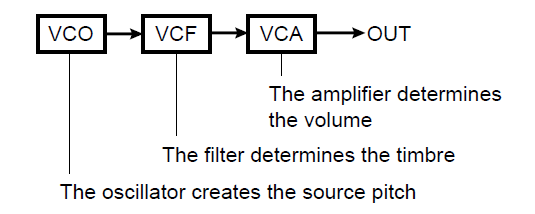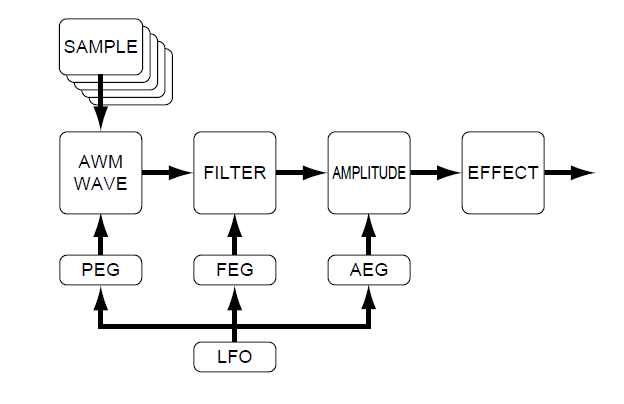Folks,
I've been editing sounds and producing new ones from the MOXF onboard waves (starting with the saws, triangles, sines, pulses in the Wv category). I've learned to use the element-level envelope sculpting, and I'm familiar with ADSR envelope generators from analog synths. What I don't understand is how the front panel ADSR controls modify the AEG I've set up for the elements. Are there diagrams online (or in the manual) that explain this? (I do understand that the front panel controls operate on all the elements, or like a Common set of voice parameters.)
A related question --- What are the units of time in the ak, dcv1, dcv2, and rel times in the element-level envelopes?
A second related questions --- Can one get the front panel ADSR controls to set the FILTER envelope as well as the amplitude envelope?
Thanks
Todd
Hi Todd,
Thanks for the questions...
I've been editing sounds and producing new ones from the MOXF onboard waves (starting with the saws, triangles, sines, pulses in the Wv category). I've learned to use the element-level envelope sculpting, and I'm familiar with ADSR envelope generators from analog synths. What I don't understand is how the front panel ADSR controls modify the AEG I've set up for the elements. Are there diagrams online (or in the manual) that explain this? (I do understand that the front panel controls operate on all the elements, or like a Common set of voice parameters.)
If you are familiar with ADSR from analog synthesizers, we can build on that knowledge. In your typical analog synth all of your Oscillators went through the one ADSR— which you used to shape the Amplitude (loudness) of the entire sound.

What you need to get your head around with the AWM2 (sample playback) engine, each Element (there are 8 per Voice) has its own Amplitude Envelope Generator. And not only that, but each Element has its own Filter Envelope Generator, and each Element has its own Pitch Envelope Generator. Each Element is a recreation of the Osc-Filter-Amp paradigm.

This is one reason (beyond the actual recording of Audio as the source Waveform) that these type of synthesizers can be so highly emulative. You have control over more of the details that make an instrument sound playable. In fact, it is almost TOO MUCH control. In an eight Element AWM2 sound, you can have eight completely separate Filters (one per Element), and each could be set totally independently. Each could be a different Type entirely. If you wanted to open a Filter on an analog synth — well since there was only one it was easy, you just grabbed the Cutoff Knob and opened the only filter available.
The thing about the sample based AWM2 is you have eight separate filters with eight separate Filter Envelope Generators... with eight separate Cutoff frequencies. Great for the detailed programming within the sound, but say all you want to do is brighten the sound a bit?
This is when having 8 separate filters to open would be TOO MUCH control...
That’s were the Quick Edit Knob Functions come in... you have a Knob labeled “Cutoff” and one labeled “Resonance”, and “FEG Depth”... but they are not a filter, per se. These Knobs are connected to the 8 Filters assigned to the 8 Elements. And act as an Offset. Turning the “Cutoff” Knob clockwise applies an Offset to all 8 Filters raising the Cutoff frequency from its current value in a positive direction. If all eight Elements were set to “THRU” (meaning no filter assigned) then turning the Cutoff Knob would do nothing (it is Not a Filter, it is rather a Knob that applies an Offset to all currently active Filters.
The Attack, Decay, Sustain Release Knob parameters are Offsets to the 8 AEGs of the 8 Elements. Without this Offset, imagine having to manually Offset the attack on eight separate AEGs just to slow the strings sound’s attack... enter the Quick Edit Knob Functions... when COMMON is active, you are applying Offsets to all Elements together. More control does not have to be TOO MUCH because you have access to these Offsets.
When you want to work under the hood go to the Element Envelopes, when wanting to quickly offset all together go to the Knob Functions.
A related question --- What are the units of time in the ak, dcv1, dcv2, and rel times in the element-level envelopes?
The Envelopes do not a unit of time as in seconds or milliseconds, as these are settings to be made by ear. Like on an analog synth you do it “by-ear”. In general you’ll find it is not a linear scale... it has more detail in the areas were Change is the most critical. A “0” is immediate, and 127 is the longest stretch of time. But know that the difference between 9 and 10 is a whole lot less time than the distance between 119 and 120.
It’s weighted toward where you would need the most resolution (short times) when doing musical instrument emulation.
A second related questions --- Can one get the front panel ADSR controls to set the FILTER envelope as well as the amplitude envelope?
No, not the Quick Access Knobs... the Offsets available in the Knob Function area for the filter block is Cutoff, Resonance, and FEG Depth. But you can select any or all of the Filter parameters to manually control in the Control Set.
You can in the MOXF, assign control over specific Filter Envelope parameters within the Voice’s Control Set. You can choose a Source (Controller) and select FLT-Atk, FLT-D1, FLT-D2, FLT-Rel, etc, as the target Destination (Parameter)... you can choose which of the eight 8 Element’s filters will respond (all if you wish). You can choose the Assign Knobs, FC, MW, etc, etc...
Extra Credit:
Recommended reading: Learning About Envelopes
Thanks again for the question.
Brilliant - thank you! (I've assigned the Filter Env Depth to the ModWheel with good results.)
